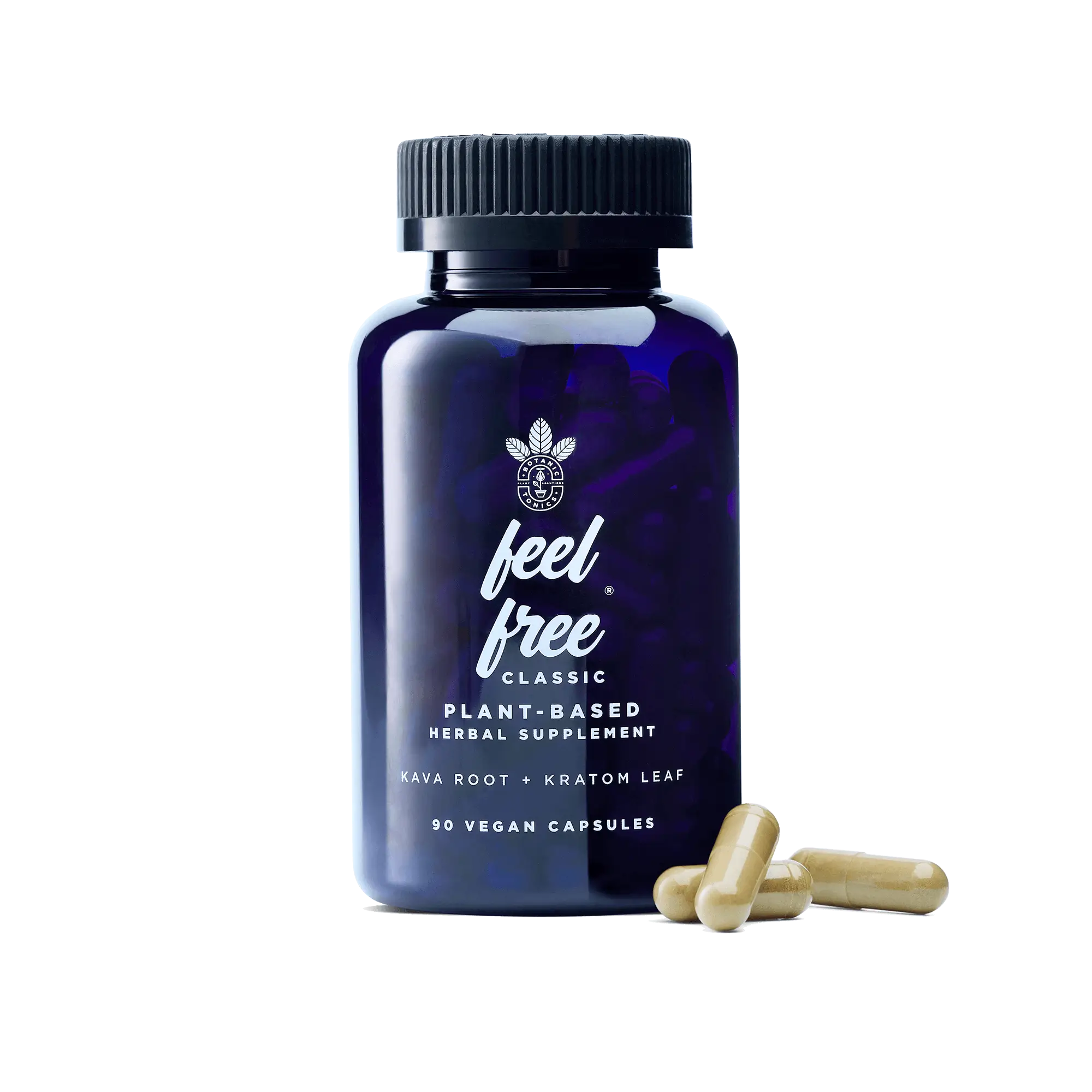The Power of Kavalactones: Identifying the Strongest Kava Varieties
Kava is no longer a secret exclusive to the South Pacific. Kava bars have sprouted up from Poughkeepsie to Portland, while kava capsules are projected to become a 4.9 million dollar market by the time we ring in 2030.[1]
Whether you consider yourself a casual kava consumer or a dedicated kavasseur, you likely want to know: What is the strongest kava kava available?
You’re wise to ask, as the potency of kava may dictate the degree of chill you feel. Here’s how the strongest kava is determined—and why it should be weighed in your quest for the best.
What Defines the Strength of Kava?

Manufactured from the roots of the Polynesian shrub Piper methysticum, kava may be as natural as lavender, valerian, and coffee.[2] And yet, just as the kick of a cup of java depends on the type of coffee and amount used in a brew, the force of kava relies on several factors.
First, though, it’s important to know how the kava plant works on your brain and body.
The Role of Kavalactones in Kava Kava’s Potency
From intensified focus to greater self-assurance in social situations, there’s no shortage of reasons not to give kava a whirl (in a half-coconut shell, or bilo, that is).[3]
These potential perks, as well as others, are due to the presence of kavalactones—or phytochemicals—that may calm your nervous system and impact a handful of crucial neurotransmitters, such as:[4,5]
- Dopamine
- Gamma-aminobutyric acid (GABA)
- Serotonin
- Norepinephrine
Put simply, kava might put your mind to rest while also loosening up your body, potentially allowing you to hone in on a work project or walk into a party with a bit more confidence and pep in your step.
Which Kavalactones are the Strongest?
Of the 19 unique kavalactones identified thus far, the three thought to deliver the most telling effects on the central nervous system are:[6]
- Methysticin
- Dihydrokavain
- Kavain
Will you see these specific kavalactones on the list of ingredients of the kava product you purchase?
Not necessarily. But you will find that many kava products name the level of kavalactones included, which typically ranges anywhere between 3% and 70%.[7,8] Naturally, the strongest kava is in the upper percentile, and kava dosages usually veer between 150mg to 300mg.
What Else Affects the Power of Kava?
How you feel after ingesting kava also depends on the following:[9]
Source of Origin
Experts suggest that herbs of any kind do best when they’re harvested in their native habitat.[10,11] When it comes to discovering the strongest kava kava, it’s widely advised to suss out products that have been derived from plants grown in the South Pacific, namely:[12]
- Vanuatu
- Fiji
- Tonga
- Samoa
- Hawai’i
- Papua New Guinea
- Pohnpei (Micronesia)
Growing Conditions
The soil in which kava plant is harvested, as well as the amount of water and sunlight the Piper methysticum receives, has a hand in the amount of kavalactones a kava product boasts.[13]
Preparation
Traditionally, kava is ground from the washed, dried roots of the South Pacific plant before the pharmacological compounds are extracted with water; in some cultures, this process is conducted by chewing the kava root and spitting it out before it’s brewed with coconut milk or water. (Today, this extraction method has been mechanized to expedite the process.)
The ratio of this pulverized kava powder to liquid also has a direct effect on kava’s potency. The same goes for the kava extract solvent used.[14]
To recap, kava is traditionally processed with water, but the contemporary demand for the crop has introduced the use of ethanol and acetone. To date, acetone yields the highest kavalactone content.
Production
It’s also important to note that herbal products are notorious for going through several processes before they reach your favorite health food market or land in your mailbox. This suggests that smaller, fresher batches of kava will ignite the most immediate, deeply felt results.
Quality
The quality of the manufacturer and its products plays a primary role in the strength of kava as well.
If you elect to go with the least expensive kava kava you can find, chances are high it’ll have less efficacy than a quality kava tea, powder, tonic, or capsule—especially once you account for the possibility that products rolled out by “budget” manufacturers may contain fillers and contaminants (and these, too, can influence kava’s effects).
Individual Factors
It’s certainly not news that foods, beverages, substances, and supplements hit people in wildly divergent ways. A cup of coffee might offer you just the boost you need for your commute, while it may send your significant other shooting through the roof.
Similarly, the perceived strength of kava also hinges on your:
- Overall health
- Body type and size
- Nutritional status (i.e., whether you consumed kava on a full or empty stomach)
- Tolerance to kava—for example, if you’re taking kava for the first time or the fiftieth time
- The presence of other drugs in your system, such as benzos like Valium (both of which should be avoided completely if you plan on indulging in kava)
Lastly, the strain of kava impacts its ultimate potency—a topic we’ll look into next.
Comparing the Strengths of Different Kava Strains
No matter if you call it sakau in Pohnpei or ‘awa on Maui, kava kava is typically—and broadly— broken down into two strains: noble and tudei (or two-day) kava. Noble kava is generally considered the better of the two—hence its name.
That said, it’s a bit more nuanced than that—and happening upon the strongest kava kava relies on understanding its “genetic streak,” which is nourished by its cultivator. Vanuatu, for example, has a number of distinctive strains, from the creativity-inspiring “eva kava” to the sleep-promoting, heavier strain, “borongoru.”[15]
Because of the sheer number of kava strains (an estimated 100-plus), it’s best to follow this general rule of thumb: Go with noble kava to reap the most rewards with the least potential for negative side effects (which are more frequently associated with tudei kava), like:[16]
- Dizziness
- Restlessness
- Abdominal upset
- Contact dermatitis (aka, an itchy rash)
How to Choose the Strongest Kava for Your Needs
Think of a time you selected an herbal remedy for something that was bothering you—such as chamomile for sleep or ashwagandha for stress.[17,18] You started with what you hoped to accomplish (relief from insomnia and anxiety, in these cases) and took it from there.
The same logic should be applied to the strongest kava strain you select:
For enhanced social bonding – Whether it’s a holiday bash in a new city or a first date that’s giving you jitters, consider seeking out Melo Melo—a kava strain from Vanuatu that has a muted effect but is still praised for the sweeter, more relaxed mood it may stimulate.For sharper focus – Finding your flow while working from home can be a genuine challenge, especially on days when your attention is being pulled in multiple directions (the dog, the cat, snacks, the irresistible urge to organize your bookshelf by color). Rather than reaching for yet another shot of espresso, experiment with eva kava instead: Eva has higher concentrations of kavain and dihydrokavain (two of the kavalactones we mentioned earlier), which may bolster the plant’s concentration-boosting powers. For waking up feeling refreshed – Rest may elude busy minds that seem perpetually hijacked by to-do lists. “Heavier” forms of kava, such as borongoru, may assist with this: The Vanuatu strain was crafted for sleep.
As you sift through the strongest kava products available, bear in mind the appropriate dosage for your desired effect. If you want to relish the more sociable, chill side of the crop, opt for a product that contains 150mg to 260mg of kava. Yearning for an even more soothing vibe? Products that contain between 260mg and 300mg of kava might just do the trick. Try adding your product to a kava tonic recipe for a calm and enjoyable experience.
Are There Any Signs That Your Kava Product is Too Strong?
Definitely. Seek medical assistance right away if you experience:
- Intestinal distress, such as nausea, vomiting, or stomach pain
- Acute exhaustion or fatigue
- Increased body temperature
- Loss of appetite
- Off-colored, brownish urine
- Jaundice
Rest assured that these side effects are rare—and that the World Health Organization (WHO) characterizes the risk of kava toxicity as “very low.”[19] Still, as with anything you consume, the risk of experiencing side effects may increase with the product’s potency—and how much of it you ingest.
Nonetheless, consider these possible side effects one more reason to consult with your physician before trying out any new herb or supplement (yes, even if they’re from Mother Nature). Additionally, experiment with kava prudently. Gradually increasing your dosage and usage will help you land on that magic number.
Finally, be sure to shop for kava from a highly regarded manufacturer whose products are not only harvested from noble kava but also free of harm-inducing compounds like heavy metals.
Boost your energy and focus with feel free

Whether it’s chocolate, coffee, or tea, many of us crave the “strongest” and “best” products, hoping they’ll come with amplified effects. The strongest kava depends on the considerations listed here—chiefly, the level of kavalactones it contains, and whether it falls into the “noble kava” camp.
Research is always advised before you attempt anything new—but Botanic Tonics has already done the homework for you. Our feel free CLASSIC tonic and feel free capsules are rich in kavalactones.
Experience the myriad benefits of kava with Botanic Tonics, where we don’t just strive for quality—we insist on it.
Sources:
- Verified Market Research. Kava extract supplements market size and forecast. https://www.verifiedmarketresearch.com/product/kava-extract-supplements-market/
- Cleveland Clinic. When it comes to kava, ‘natural’ doesn’t mean safe. https://health.clevelandclinic.org/what-is-kava/
- Healthline. Kava kava: benefits, side effects and dosage. https://www.healthline.com/nutrition/kava-kava#TOC_TITLE_HDR_5
- UCLA Health. Ask the doctors-what are the risks and benefits of kava? https://www.uclahealth.org/news/ask-the-doctors-what-are-the-risks-and-benefits-of-kava
- Science Direct. Kavalactones. https://www.sciencedirect.com/topics/neuroscience/kavalactones
- Journal of Clinical Medicine. An updated review on the psychoactive, toxic and anticancer properties of kava. https://www.ncbi.nlm.nih.gov/pmc/articles/PMC9315573/
- Science Direct. Kava extract. https://www.sciencedirect.com/topics/medicine-and-dentistry/kava-extract
- New York University Langone Health, Department of Surgery. Kava.
- Poison Control. Kava kava. https://www.poison.org/articles/kava
- Healthline. Herbal medicine 101: how to harness the power of healing herbs. https://www.healthline.com/health/herbal-medicine-101-harness-the-power-of-healing-herbs#what-to-look-for
- Specialty Crops for Pacific Island Agroforestry. Farm and forestry production and marketing profile for kava. http://www.agroforestry.net/images/pdfs/Kava_specialty_crop.pdf
- University of Hawaii at Manoa Library. Traditional Pacific Island crops: kava. https://guides.library.manoa.hawaii.edu/paccrops/kava
- Better Health Channel. Kava. https://www.betterhealth.vic.gov.au/health/healthyliving/kava#
- Nutrients. Kava as a clinical nutrient: promises and challenges. https://www.ncbi.nlm.nih.gov/pmc/articles/PMC7600512/
- Botanic Tonics. 5 types of kava strains. https://botanictonics.com/blogs/botanic-secrets/5-types-of-kava-strains-botanic-tonics
- Mount Sinai. Kava kava. https://www.mountsinai.org/health-library/herb/kava-kava
- Hindawi. Plant extracts for sleep disturbances: a systematic review. https://www.ncbi.nlm.nih.gov/pmc/articles/PMC7191368/
- Healthline. The no bs guide to adaptogens for hormonal balance and stress. https://www.healthline.com/health/stress/smart-girls-guide-to-adaptogens#what-are-adaptogens
- World Health Organization. Kava: a review of the safety of traditional and recreational beverage consumption. https://www.fao.org/3/i5770e/i5770e.pdf
















